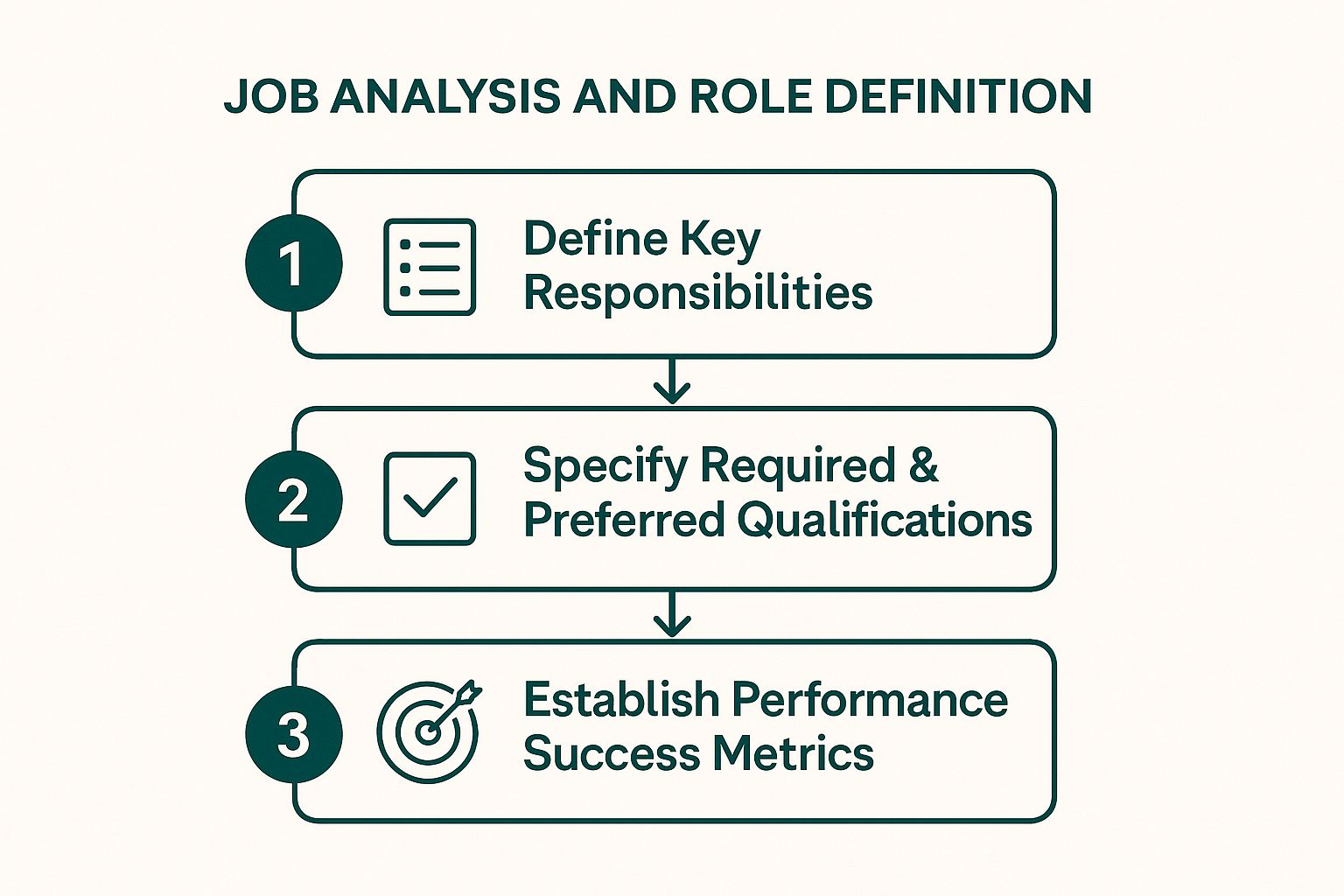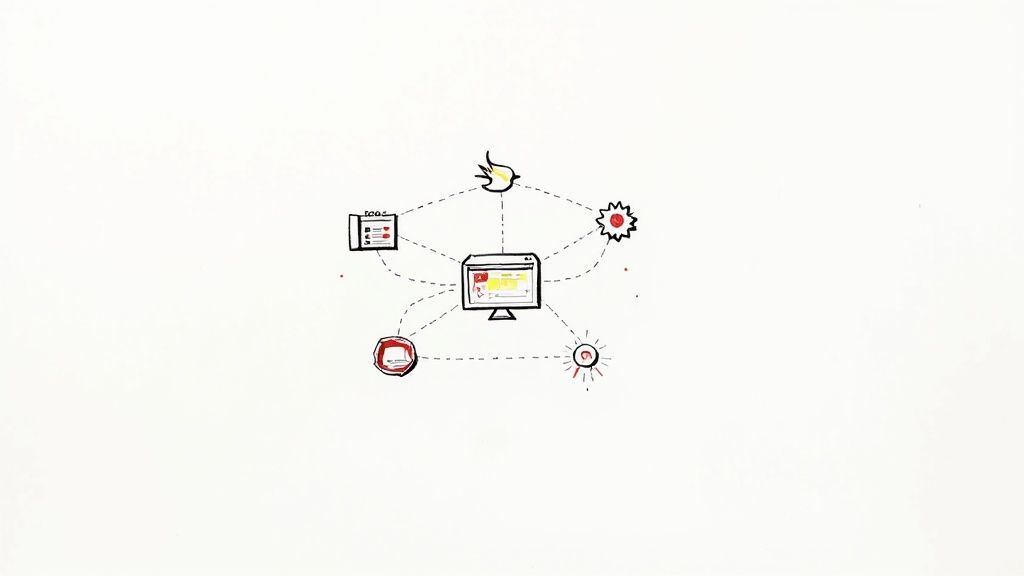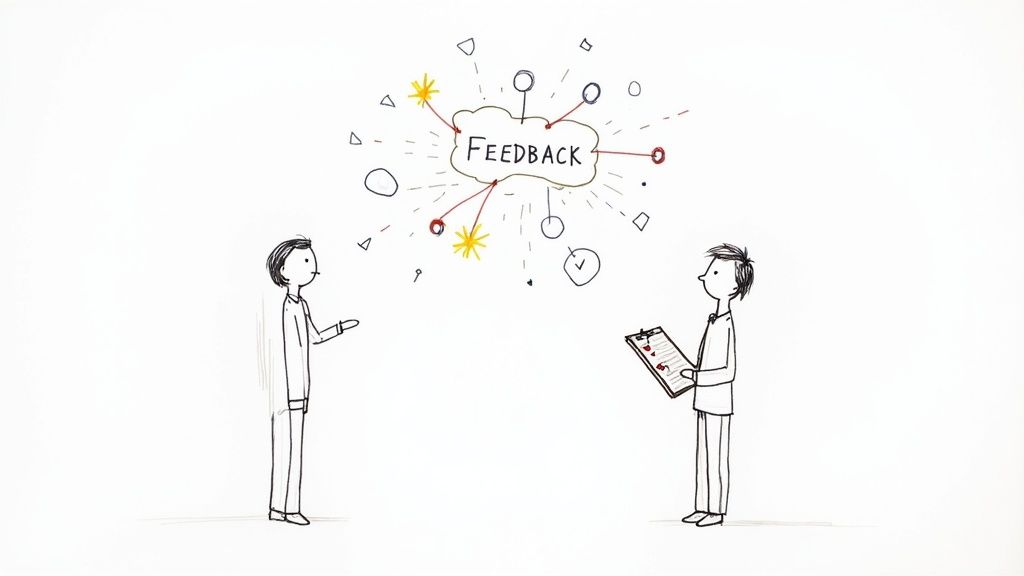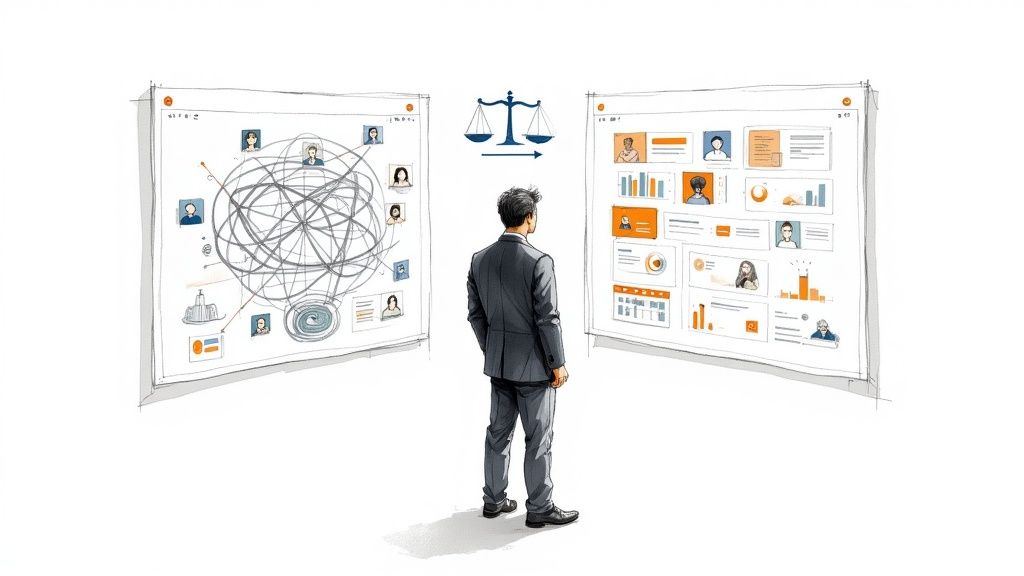In today's competitive talent market, a disorganized hiring process isn't just inefficient; it's a liability. Top candidates are often off the market in just 10 days, meaning a slow, disjointed approach can cost you the best talent. This comprehensive hiring process checklist is designed to move beyond generic advice, providing HR professionals with a strategic, step-by-step framework to attract, evaluate, and secure high-performing team members. We'll break down each of the 8 critical stages, offering actionable insights and unique strategies to transform your recruitment from a reactive chore into a proactive, talent-winning machine.
From defining the role with precision to crafting an irresistible offer, consider this your roadmap to building a more effective and candidate-friendly hiring engine. The goal is not just to fill a role but to create a structured system that consistently delivers quality hires. For a deeper dive into streamlining your entire recruitment funnel, consult this complete guide to mastering an efficient hiring process for additional strategies. This checklist will equip you with practical tools to refine every step, ensuring you never miss out on your ideal candidate due to procedural bottlenecks or a poor candidate experience. Let's get started.
1. Job Analysis and Role Definition: The Blueprint for Success
Before a single job ad is posted, the most critical work begins. Job analysis and role definition serve as the strategic foundation for your entire recruitment effort. This first step in the hiring process checklist involves more than just listing tasks; it's about deeply understanding the position's purpose, its contribution to company goals, and the specific attributes a successful candidate must possess. A well-defined role acts as a blueprint, guiding every subsequent decision from sourcing to final selection.
Why It's Foundational
A vague or inaccurate job description attracts unqualified applicants, wastes interview time, and can lead to a costly mis-hire. By contrast, a precise and thoughtful role definition ensures you attract candidates who not only have the right skills but also align with your company's culture and long-term vision. It sets clear expectations from the start, improving candidate experience and retention rates down the line.
For example, Amazon meticulously integrates its Leadership Principles into every job description, ensuring that candidates are evaluated on cultural alignment from the very first touchpoint. Similarly, Netflix's culture-focused postings prioritize values, making it clear that how you work is as important as what you can do.
Crafting a Comprehensive Role Profile
To build an effective role profile, follow these actionable tips:
- Collaborate with Stakeholders: Interview the hiring manager and current team members in similar roles. This provides invaluable insight into the day-to-day realities and unwritten expectations of the job.
- Be Transparent About Compensation: Include a salary range. This practice respects candidates' time, improves the quality of your applicant pool, and demonstrates a commitment to pay equity.
- Use Inclusive Language: Utilize tools to scan your job description for gendered or biased language to ensure you appeal to the widest possible talent pool.
- Define Success Early: Don't just list responsibilities. Clearly outline what success looks like in the first 30, 60, and 90 days. This helps candidates envision themselves in the role and gives you a framework for performance evaluation.
The following infographic illustrates the core workflow for defining a new role, breaking it down into three essential, sequential steps.

This process flow ensures that each element of the job description builds logically upon the last, resulting in a cohesive and comprehensive role profile.
2. Recruitment Strategy and Sourcing: Building Your Talent Pipeline
With a clear role profile defined, the next step in the hiring process checklist is to build a strategic plan for finding your ideal candidates. Recruitment strategy and sourcing involve moving beyond a "post and pray" approach to proactively identify and engage top talent. This means creating a multi-channel plan that outlines where to find qualified candidates, how to reach them effectively, and which tools to use to manage the process, all while aligning with your budget and timeline.

Why It's Foundational
A well-executed sourcing strategy ensures you are fishing in the right ponds, saving time and resources while significantly improving the quality of your applicant pool. It allows you to reach both active job seekers and passive candidates, the latter of whom often represent the highest-quality talent. This proactive approach, championed by thought leaders like Laszlo Bock with his data-driven methods at Google, transforms recruitment from a reactive necessity into a strategic business function.
For example, Salesforce builds a robust future talent pipeline through its comprehensive university recruitment program, while HubSpot incentivizes its team to find great fits with a generous employee referral program. These companies understand that the best candidates may not always come through traditional job boards.
Crafting a Winning Sourcing Strategy
To build an effective recruitment strategy, use these actionable tips:
- Track Source Effectiveness: Use your Applicant Tracking System (ATS) to analyze which channels deliver the highest-quality candidates. Double down on what works and cut spending on what doesn’t.
- Leverage Employee Networks: Implement a structured referral program with clear incentives. Your employees' networks are a powerful and often-untapped source of pre-vetted, culturally aligned talent.
- Tailor Your Outreach: Customize your job postings and outreach messages for each platform. A post for LinkedIn should sound different from one on a niche industry forum or social media.
- Master Boolean Search: Go beyond simple keyword searches on platforms like LinkedIn Recruiter. Using Boolean operators (AND, OR, NOT) and modifiers allows you to pinpoint candidates with the exact skills and experience you need.
3. Application Screening and Initial Review: Finding the Needle in the Haystack
With a compelling job ad now live, the applications begin to pour in. The next crucial step in the hiring process checklist is application screening, the systematic process of filtering this large volume of candidates to a manageable shortlist. This stage is a critical efficiency lever, using technology and defined criteria to quickly identify individuals who meet the essential qualifications for the role.

Why It's Foundational
Effective screening saves countless hours by ensuring that hiring managers only interview relevant, qualified candidates. Without a structured approach, this phase can become a major bottleneck, leading to slow hiring times and a poor candidate experience. A well-executed screening process not only speeds up hiring but also improves the quality of candidates who advance, setting the stage for more productive interviews.
For instance, Unilever famously uses an AI-powered system that analyzes applications and initial video interviews, reducing its initial screening time by over 75%. Similarly, Goldman Sachs has implemented blind resume reviews for certain roles, removing identifying information to mitigate bias and improve diversity in its talent pipeline.
Crafting an Efficient Screening Process
To build a fair and effective screening workflow, follow these actionable tips:
- Establish Clear Knockout Criteria: Define a short list of non-negotiable requirements (e.g., a specific certification, legal right to work). If a candidate doesn't meet these, they are automatically disqualified, allowing you to focus on the most promising applicants.
- Utilize Structured Scorecards: Create a simple scorecard based on the job description’s key requirements. Score each application against these criteria for a consistent, data-driven evaluation process that minimizes personal bias.
- Audit Your ATS Filters: If using an Applicant Tracking System, regularly review and update your keyword filters. Outdated or poorly configured filters can inadvertently screen out highly qualified, non-traditional candidates.
- Train Your Screening Team: Ensure everyone involved in screening is trained on unconscious bias. This awareness is key to building a more diverse and inclusive workforce. You can learn more about how to refine your process by exploring different approaches to automated candidate screening.
4. Phone/Video Screening Interviews: The First Conversation
After sourcing and shortlisting, the initial phone or video screening is your first direct interaction with a candidate. This brief but crucial step in the hiring process checklist, typically lasting 15 to 30 minutes, serves as a high-efficiency filter. It's designed to quickly assess core qualifications, confirm mutual interest, and evaluate communication skills before committing significant time and resources to in-depth interviews. This stage is a two-way street, giving candidates their first real impression of your company's professionalism and culture.
Why It's Foundational
A well-executed screening call saves everyone time. It swiftly identifies candidates who, despite a strong resume, may have deal-breaking misalignments in salary expectations, availability, or career goals. This allows you to focus your team's energy on the most promising individuals. More importantly, it ensures that candidates moving forward are genuinely engaged and informed, creating a more positive and productive experience for the subsequent, more intensive interview stages.
For example, a company like Buffer, known for its remote-first model, uses initial video screens to assess not just skills but a candidate's suitability for autonomous, distributed work. Similarly, Deloitte often employs structured phone interviews with behavioral questions even at this early stage, ensuring alignment with their competency framework from the very first conversation.
Crafting an Effective Screening Process
To make your screening calls as productive as possible, follow these actionable tips:
- Standardize Your Questions: Prepare a core set of questions for every candidate to ensure a fair and consistent evaluation process. This allows for easier comparison and reduces unconscious bias.
- Start with Their Questions: Begin the call by asking the candidate what they want to know about the role or company. This builds immediate rapport and demonstrates that the conversation is a mutual exploration.
- Be Transparent About Compensation: Discuss the salary range early. This respects the candidate's time and ensures you are both aligned, preventing surprises later in the process.
- Test Your Tech: If conducting a video screen, test your platform beforehand and have a backup plan, like a phone number, ready. Technical glitches can create a poor first impression.
5. In-Person or Virtual Panel Interviews
Once candidates are shortlisted, the panel interview stage provides a comprehensive, multi-perspective evaluation. Whether conducted in-person or virtually, this step involves multiple stakeholders simultaneously engaging with a candidate. It moves beyond a one-on-one conversation to a holistic assessment of skills, cultural fit, and team dynamics, making it a cornerstone of any robust hiring process checklist. A well-orchestrated panel allows for a deeper dive into behavioral competencies, technical abilities, and problem-solving skills in a single, efficient session.

Why It's Foundational
Relying on a single interviewer's perspective can introduce unconscious bias and result in an incomplete picture of the candidate. Panel interviews mitigate this risk by gathering diverse viewpoints, leading to a more objective and well-rounded hiring decision. This collaborative approach also demonstrates your company's investment in the hiring process to the candidate, improving their experience and providing a realistic preview of the team they might join.
Google, under the influence of Laszlo Bock, famously uses structured, cross-functional panel interviews to assess candidates against specific attributes. Similarly, McKinsey's case study interviews are conducted by consultant teams to evaluate analytical and collaborative skills in a real-world context, ensuring that candidates are vetted from multiple angles for both capability and fit.
Crafting an Effective Panel Interview
To maximize the value of your panel interviews, follow these actionable tips:
- Assign Specific Competencies: Designate a focus area (e.g., technical skills, leadership, cultural fit) for each interviewer to prevent redundant questioning and ensure comprehensive coverage.
- Use a Standardized Rubric: Equip panelists with a scoring rubric and standardized evaluation form. This creates consistency and allows for a fair, data-driven comparison between candidates.
- Debrief Immediately: Schedule a brief huddle for the panel right after the interview. This allows everyone to share their impressions while they are still fresh and make a collective, informed decision.
- Provide a Clear Agenda: Share the interview schedule, list of interviewers, and general topics with the candidate beforehand. This transparency reduces anxiety and helps them prepare, leading to a more productive conversation. For more insights on setting candidates up for success in video formats, explore these pro tips for mastering on-demand video interviews.
The following video from Lou Adler explains how to structure interviews to accurately predict on-the-job performance, a key goal of the panel format.
By structuring your panel interviews, you transform them from a simple conversation into a powerful predictive tool for hiring success.
6. Reference and Background Checks: Verifying Trust and Competence
Once you've identified a top candidate, the final due diligence step is crucial for mitigating risk and validating your selection. Reference and background checks are the formal process of verifying a candidate's credentials, employment history, and professional reputation. This phase of the hiring process checklist moves beyond what the candidate has told you, seeking third-party validation to ensure you have a complete and accurate picture before extending an offer.
Why It's Foundational
Skipping this step can lead to significant problems, including performance issues, workplace safety concerns, or even legal liabilities. A thorough check confirms the candidate's claims, provides insight into their past performance and work ethic, and ensures they meet any legal or regulatory requirements for the role. It’s a critical safeguard that protects your organization, team, and culture from a potential mis-hire.
For example, financial services firms conduct comprehensive credit and criminal background checks to comply with industry regulations and protect assets. Similarly, healthcare organizations must meticulously verify licenses and check for any malpractice history to ensure patient safety and maintain compliance.
Conducting Effective Checks
To execute this step with professionalism and legal compliance, follow these actionable tips:
- Always Obtain Written Consent: Before initiating any background or reference check, secure explicit, written permission from the candidate. This is a legal requirement in many jurisdictions and a cornerstone of a respectful candidate experience.
- Ask Specific, Job-Relevant Questions: During reference calls, avoid generic questions. Instead, ask behavior-based questions tied to the role’s key competencies. For instance, "Can you describe a time when the candidate had to manage a tight deadline?"
- Maintain Consistency: Use a standardized set of questions for all candidates for a given role. This ensures fairness and makes it easier to compare feedback objectively across your finalist pool.
- Address Discrepancies Professionally: If a check reveals negative information or a discrepancy, give the candidate an opportunity to explain. This approach is fair and can often clarify misunderstandings.
By integrating these verification steps, you add a final layer of confidence to your hiring decision. For a deeper dive into the legal and practical aspects, you can learn more about the pre-employment screening process.
7. Final Decision Making and Offer Preparation: The Decisive Moment
After extensive interviews, assessments, and reference checks, the hiring process checklist arrives at its critical juncture. This is where all collected data converges for the final hiring decision. This stage involves a systematic evaluation of each finalist against the core requirements of the role, team dynamics, and broader company objectives. It's a collaborative effort to select the single best candidate, followed by the meticulous preparation of a compelling and competitive job offer.
Why It's Foundational
A structured decision-making process minimizes bias and ensures the choice is based on objective evidence rather than gut feelings. It safeguards against inconsistent hiring standards and strengthens the rationale behind the selection, which is vital for compliance and feedback. A well-researched, thoughtfully prepared offer demonstrates your company's professionalism and genuine interest, significantly increasing the likelihood of acceptance and setting the stage for a positive employment relationship.
For instance, Google famously uses hiring committees to review candidate packets, ensuring that decisions are data-driven and calibrated across the organization. Similarly, Salesforce conducts an equality-focused compensation review for every offer, ensuring fair pay and reinforcing its commitment to its values.
Making the Right Choice and Offer
To navigate this final step effectively, follow these actionable tips:
- Use a Decision Matrix: Create a scorecard with weighted criteria based on the role’s key success factors (e.g., technical skills, cultural alignment, leadership potential). Score each finalist against these criteria to facilitate an objective comparison.
- Document the Rationale: Clearly document why the chosen candidate was selected and why others were not. This provides valuable feedback for unsuccessful candidates and serves as crucial compliance documentation.
- Benchmark Compensation Aggressively: Research market salary data from multiple reliable sources to build a competitive offer. Go beyond base pay and consider total compensation, including bonuses, equity, and benefits.
- Prepare for Negotiation: Define a clear salary band and anticipate potential negotiations. Know your walk-away point but also identify non-monetary perks (like professional development funds or flexible hours) that can add value.
- Keep Backup Candidates Warm: Maintain communication with your second-choice candidate until the offer is officially accepted. This provides a crucial fallback option if your primary choice declines.
8. Offer Negotiation and Onboarding Preparation: Sealing the Deal and Setting the Stage
The final stretch of the hiring process checklist is where a promising candidate becomes a new team member. This phase involves extending the formal job offer, skillfully managing negotiations, and immediately transitioning into pre-onboarding activities. It’s a critical moment that sets the tone for the entire employment relationship, turning recruitment momentum into long-term retention.
Why It's Foundational
A clumsy offer or a cold, silent period after acceptance can undo all the hard work that came before, creating last-minute doubts for your top choice. A seamless transition from candidate to new hire reinforces their decision to join your company. It demonstrates professionalism, organization, and a genuine excitement to have them on board, laying the groundwork for a successful and engaging start.
For example, HubSpot sends a comprehensive welcome package with company swag and personalized notes, making new hires feel valued before day one. Zappos, famously popularized by Tony Hsieh, has long been a benchmark for culture-focused immersion, starting its onboarding experience the moment an offer is accepted to build deep cultural alignment.
Crafting a Winning Offer and Welcome Experience
To navigate this final stage effectively, follow these actionable tips:
- Present the Offer with Enthusiasm: Extend the verbal offer over the phone. Convey genuine excitement and reiterate why they are the chosen candidate, highlighting specific growth opportunities and how their skills align with the company's vision.
- Prepare for Negotiations: Anticipate common negotiation points like salary, start date, or remote work flexibility. Work with the hiring manager to establish pre-approved ranges and responses to handle these conversations smoothly and decisively.
- Set Clear Deadlines: To maintain momentum and manage your pipeline, provide a clear, reasonable deadline for the candidate to accept the offer. A typical timeframe is 24 to 48 hours.
- Begin Onboarding Immediately: Once the offer is accepted, the focus shifts to ensuring a smooth transition for the new hire. Explore further insights into effective onboarding strategies to create a structured and welcoming experience. Start by sending a welcome email from the team, providing access to necessary paperwork, and sharing a high-level schedule for their first week.
8-Step Hiring Process Comparison
| Item | Implementation Complexity 🔄 | Resource Requirements ⚡ | Expected Outcomes 📊 | Ideal Use Cases 💡 | Key Advantages ⭐ |
|---|---|---|---|---|---|
| Job Analysis and Role Definition | High – requires multiple stakeholder inputs | Moderate – time-intensive but low tech needs | Clear role expectations, attracts qualified talent | Foundational for all hiring processes | Attracts right candidates, legal compliance |
| Recruitment Strategy and Sourcing | Moderate to High – multi-channel management | High – time, budget, and platform management | Broad & diverse candidate pool, faster hiring | Expanding candidate reach for various roles | Increases candidate diversity and employer brand |
| Application Screening and Initial Review | Moderate – requires ATS integration and calibration | Moderate – ATS software and trained reviewers | Efficient, consistent candidate shortlisting | High-volume applications, initial qualification screening | Saves time, reduces bias, audits compliance |
| Phone/Video Screening Interviews | Low to Moderate – scheduling and technology setup | Low – minimal logistics and interviewer time | Early candidate fit assessment, clarifies expectations | Initial candidate narrowing, remote screening | Cost-effective, real-time clarification |
| In-Person or Virtual Panel Interviews | High – coordinate multiple interviewers | High – significant interviewer time investment | Comprehensive skill and cultural fit evaluation | Final candidate assessment for critical roles | Reduces bias, multi-perspective evaluation |
| Reference and Background Checks | Moderate – verification process and legal checks | Moderate to High – time and potential service cost | Validates candidate info, reduces hiring risks | Final pre-offer validation, risk management | Reduces bad hires, objective third-party insight |
| Final Decision Making and Offer Preparation | Moderate to High – consensus building & data analysis | Moderate – stakeholder coordination | Objective hiring decisions and competitive offers | Final selection stage, offer crafting | Structured, bias-reducing, well-justified offers |
| Offer Negotiation and Onboarding Preparation | Moderate – negotiation management and onboarding setup | High – cross-department coordination | Candidate acceptance, smooth new hire transition | Post-offer acceptance and new employee integration | Improves retention, positive first impression |
Transform Your Hiring from a Process into a Competitive Advantage
Navigating the complexities of modern recruitment requires more than intuition; it demands a systematic, repeatable, and strategic approach. The comprehensive hiring process checklist we have explored moves beyond a simple to-do list. It serves as a foundational blueprint for building a high-performing team, ensuring every step, from initial job analysis to final onboarding preparations, is executed with precision, fairness, and a focus on long-term success. By diligently following these stages, you are not just filling an open position; you are making a critical investment in your organization's future.
The true power of this checklist lies in its ability to transform hiring from a reactive, administrative function into a proactive, strategic advantage. Each checkpoint, whether it's defining precise role requirements, diversifying your sourcing channels, or conducting structured interviews, is an opportunity to strengthen your employer brand and deliver an exceptional candidate experience. A well-managed process signals professionalism and respect, leaving every applicant, successful or not, with a positive impression of your company.
Key Takeaways for Strategic Implementation
To elevate your recruitment efforts, focus on these core principles:
- Consistency is Crucial: Applying the same structured criteria and interview questions to all candidates is the single most effective way to mitigate unconscious bias and ensure fair, equitable evaluations. This creates a level playing field where decisions are based on merit and capability.
- Experience is Everything: Remember that you are not just evaluating candidates; they are evaluating you. Every interaction, from the initial application confirmation to the final offer call, shapes their perception of your company culture and values. A seamless, communicative process is a powerful recruitment tool.
- Data-Driven Decisions: Move away from "gut feelings." Use scorecards, structured feedback mechanisms, and collaborative review sessions to make objective, evidence-based hiring choices. This rigor significantly improves the quality of hire and reduces costly turnover.
Your Actionable Next Steps
Mastering this checklist is an ongoing commitment to refinement and improvement. Start by auditing your current hiring workflow against the steps outlined in this article. Identify the bottlenecks, the areas lacking structure, and the communication gaps. Implement one or two improvements at a time, such as introducing a standardized screening scorecard or creating a formal reference check template.
To truly transform your hiring process into a competitive advantage, understanding and integrating workflow automation can significantly streamline operations and free your team from repetitive tasks. By automating manual steps like scheduling and initial communication, your talent acquisition professionals can dedicate their valuable time to what matters most: building meaningful relationships with top-tier candidates. This shift from administrative burden to strategic engagement is where world-class recruitment teams separate themselves from the pack. Ultimately, a robust hiring process checklist is not a constraint but a framework for freedom, enabling you to hire smarter, faster, and more effectively.
Ready to eliminate scheduling headaches and automate your initial screening process? Discover how Async Interview can integrate seamlessly into your hiring process checklist, allowing you to screen more candidates in less time and focus your energy on the most promising talent. Learn more and get started with Async Interview today.




